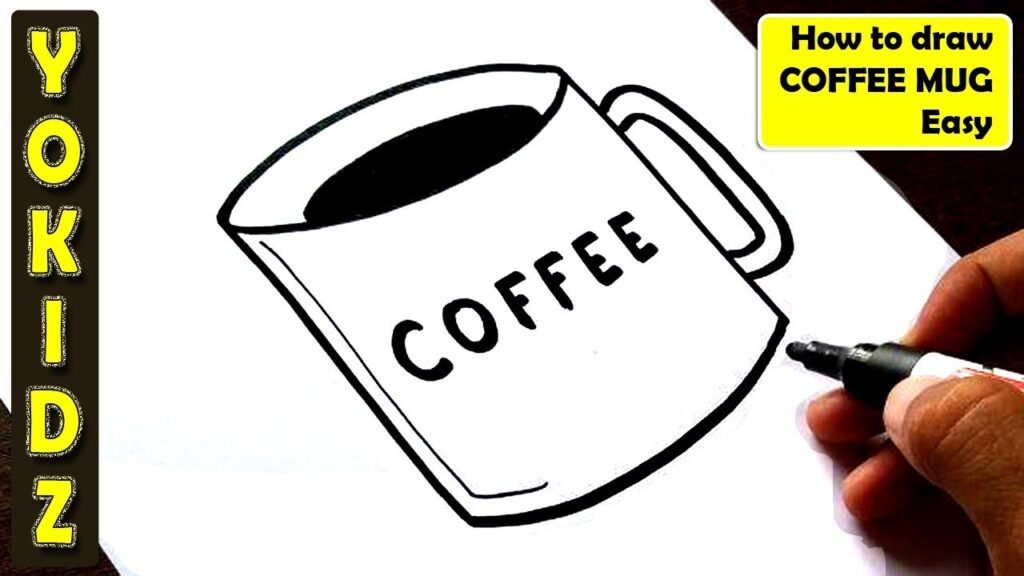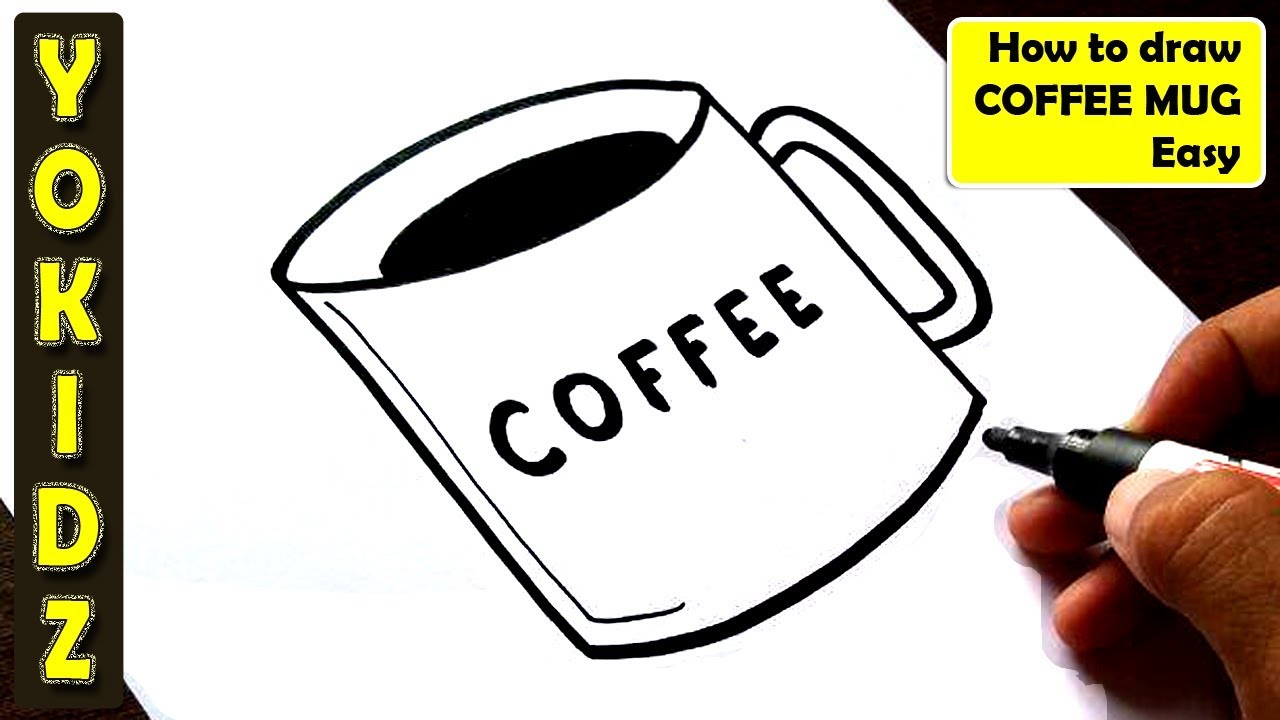
From Sketch to Sip: A Comprehensive Guide on How to Draw a Coffee Cup
The aroma of freshly brewed coffee, the warmth of the ceramic against your hands – the simple act of enjoying a coffee cup is a daily ritual for millions. But have you ever considered the aesthetic appeal of the vessel itself? Learning how to draw a coffee cup is more than just a simple exercise; it’s a gateway to understanding perspective, light, and shadow, and a delightful way to express your creativity. This guide offers a comprehensive, step-by-step approach, perfect for beginners and experienced artists alike.
Whether you’re a seasoned artist looking to refine your skills or a complete novice eager to explore the world of drawing, this article provides a structured pathway to mastering the art of sketching a coffee cup. We’ll delve into the fundamental shapes, explore techniques for adding dimension, and provide tips for achieving a realistic and visually appealing final product. The goal is not just to replicate a coffee cup, but to understand the underlying principles that bring it to life on paper.
Gathering Your Supplies: The Tools of the Trade
Before embarking on your artistic journey, it’s essential to gather the necessary materials. Fortunately, drawing a coffee cup doesn’t require a vast collection of expensive equipment. A few basic tools will suffice:
- Pencils: A range of pencils with varying hardness levels is recommended. A 2H pencil is ideal for light sketching and initial outlines, while a HB or B pencil provides a good balance for general drawing. Softer pencils like 2B or 4B are excellent for shading and creating darker tones.
- Paper: Choose drawing paper with a smooth or medium surface. Avoid paper that is too thin, as it may buckle or tear easily. A sketchbook or a pad of drawing paper will work perfectly.
- Eraser: A good quality eraser is crucial for correcting mistakes and refining details. A kneaded eraser is particularly useful for lifting graphite and creating highlights.
- Sharpener: Keep your pencils sharp to achieve precise lines and details. A pencil sharpener or a craft knife will do the trick.
- Optional: A ruler can be helpful for creating straight lines and accurate proportions. A blending stump or tortillon can be used for smoothing out shading.
With these essential tools at your disposal, you’re well-equipped to begin your exploration of how to draw a coffee cup.
Breaking Down the Basics: Understanding the Structure
The seemingly simple coffee cup is a marvel of geometric design. Before putting pencil to paper, it’s crucial to understand its underlying structure. This will enable you to accurately depict the cup’s form and create a realistic representation. The key lies in breaking down the cup into its basic components:
- The Cylinder: The main body of the coffee cup is essentially a cylinder. Imagine a rectangular shape rolled into a tube. Understanding the cylindrical form is fundamental to drawing the cup’s sides and overall shape.
- The Ellipse: The top and bottom of the cup are defined by ellipses. An ellipse is a circle viewed at an angle. Practicing drawing ellipses is vital for achieving accurate proportions and perspective, especially when drawing the opening of the cup.
- The Handle: The handle is a curved shape that often takes the form of a C or a U. The handle’s shape and position will vary depending on the cup’s design.
By simplifying the coffee cup into these fundamental shapes, you can approach the drawing process with a clear understanding of its construction. This will make the process of how to draw a coffee cup significantly easier and more intuitive.
Step-by-Step Guide: Bringing Your Coffee Cup to Life
Now, let’s put theory into practice. Follow these steps to learn how to draw a coffee cup, from the initial sketch to the final shading:
- Step One: The Initial Outline: Begin by lightly sketching a vertical ellipse. This will represent the opening of the coffee cup. Below the ellipse, draw a slightly wider ellipse to indicate the bottom of the cup. Connect the two ellipses with two parallel lines, creating the basic cylindrical shape.
- Step Two: Refining the Shape: Refine the cylindrical shape by adjusting the curves and proportions. Remember, coffee cups come in various shapes and sizes. Consider the specific style of coffee cup you want to draw. Add a slight curve to the sides to give it a more realistic look.
- Step Three: Adding the Handle: Sketch the handle of the cup. Start with a curved line that extends from the side of the cup. The shape of the handle will vary depending on the type of cup. Ensure the handle is proportional to the cup’s size.
- Step Four: Defining the Details: Now, let’s add the details. This is where you can personalize your drawing. Add a rim to the top of the cup. Consider the thickness of the cup’s walls.
- Step Five: Adding Shading and Dimension: Shading is crucial for creating the illusion of depth and dimension. Identify the light source and determine where the shadows will fall. Use a softer pencil (2B or 4B) to add shading to the areas that are away from the light source. Start with light shading and gradually build up the darkness. Use a blending stump or tortillon to smooth out the shading and create a more realistic effect.
- Step Six: Refining and Finishing: Go back and refine your drawing. Erase any unnecessary lines. Add highlights to create the illusion of light reflecting off the cup. Consider adding details like a coffee stain or a design on the cup.
By following these steps, you’ll have successfully learned how to draw a coffee cup. Remember, practice is key. The more you practice, the more comfortable and confident you’ll become.
Advanced Techniques: Taking Your Drawing to the Next Level
Once you’ve mastered the basics of how to draw a coffee cup, you can explore more advanced techniques to enhance your drawings and add realism. Here are a few suggestions:
- Perspective: Experiment with different perspectives. Draw the coffee cup from various angles to improve your understanding of spatial relationships.
- Light and Shadow: Study how light interacts with the cup. Experiment with different light sources to create dramatic effects.
- Textures: Add textures to your drawings to create a more realistic appearance. Use different pencil strokes to depict the texture of the ceramic or the reflections of light.
- Color: Once you are comfortable with pencil drawing, consider adding color to your coffee cup drawings. Use colored pencils, markers, or paint to create vibrant and eye-catching illustrations.
These advanced techniques will help you elevate your drawings and develop your artistic style.
Common Mistakes and How to Avoid Them
Even experienced artists make mistakes. Here are some common pitfalls to avoid when learning how to draw a coffee cup:
- Incorrect Proportions: Ensure the proportions of the cup are accurate. Pay attention to the width, height, and the size of the handle.
- Poor Ellipses: Practice drawing ellipses to avoid misshapen circles.
- Inconsistent Shading: Maintain consistency in your shading. Make sure the shadows are placed correctly and that the shading is smooth.
- Ignoring the Light Source: Always consider the light source and how it affects the shadows and highlights.
- Rushing the Process: Take your time and enjoy the process. Drawing takes time and patience.
By being aware of these common mistakes, you can avoid them and improve your drawing skills. Remember, practice and patience are essential.
Beyond the Basics: Exploring Different Coffee Cup Styles
The beauty of how to draw a coffee cup lies in its versatility. Coffee cups come in a myriad of shapes, sizes, and designs. Experiment with different styles to broaden your artistic horizons:
- Classic Mug: The classic mug is a simple cylindrical cup with a handle. This is an excellent starting point for beginners.
- Travel Mug: Travel mugs typically have a tapered shape and a lid. They often feature a rubber grip for easy handling.
- Espresso Cup: Espresso cups are small and often have a flared shape. They are designed to hold a small amount of espresso.
- Paper Coffee Cup: Paper coffee cups are ubiquitous. They offer an interesting challenge due to their conical shape and the often-complex designs printed on them.
- Specialty Cups: Explore drawing coffee cups with unique designs, patterns, or shapes.
By exploring different coffee cup styles, you can expand your artistic repertoire and develop your own unique drawing style.
The Benefits of Drawing: More Than Just Art
Learning how to draw a coffee cup offers benefits that extend far beyond the realm of art. Drawing cultivates several valuable skills:
- Observation Skills: Drawing requires close observation of the subject. This enhances your ability to perceive details and understand the world around you.
- Hand-Eye Coordination: Drawing improves hand-eye coordination, which is essential for various activities.
- Patience and Focus: Drawing requires patience and focus. It is a great way to relax and de-stress.
- Creativity and Self-Expression: Drawing allows you to express your creativity and explore your artistic abilities.
- Problem-Solving: Drawing can improve problem-solving skills as you learn to analyze shapes, light, and shadow.
Drawing is a valuable skill that provides numerous benefits. It is a great way to relax, express your creativity, and improve your cognitive abilities.
Conclusion: Embark on Your Artistic Journey
Learning how to draw a coffee cup is a rewarding experience. This comprehensive guide has provided you with the knowledge and techniques to get started. Remember, practice is key. The more you practice, the better you will become. Don’t be afraid to experiment, explore different styles, and develop your own unique artistic voice. Embrace the journey, and enjoy the process of creating beautiful drawings. The world of art is waiting to be explored, and the humble coffee cup is an excellent starting point.
Drawing a coffee cup is a fun and accessible activity for artists of all skill levels. By following this guide, you’ve gained the foundational knowledge of how to draw a coffee cup. Now, grab your pencils and paper and begin your artistic adventure! [See also: Drawing Basics for Beginners, Understanding Perspective in Art, How to Draw a Realistic Still Life]


